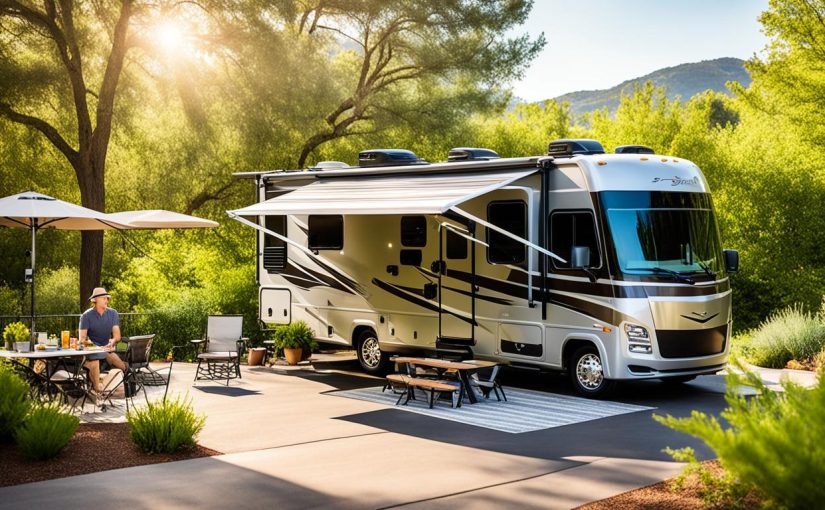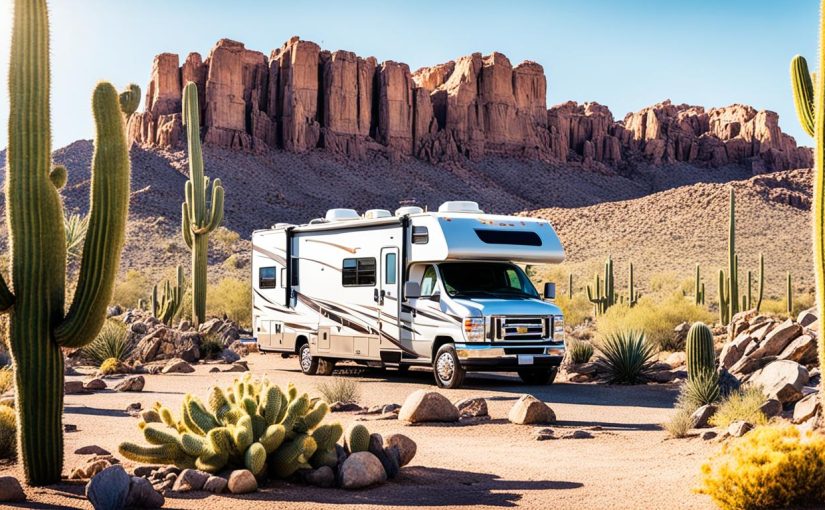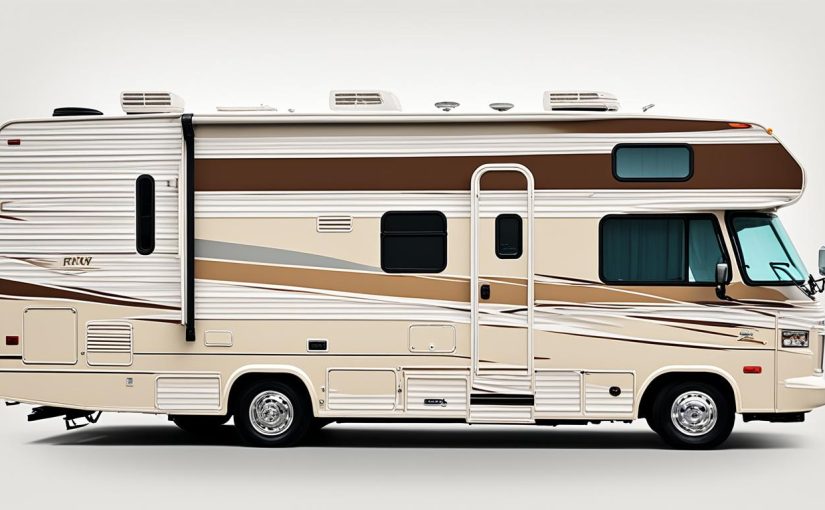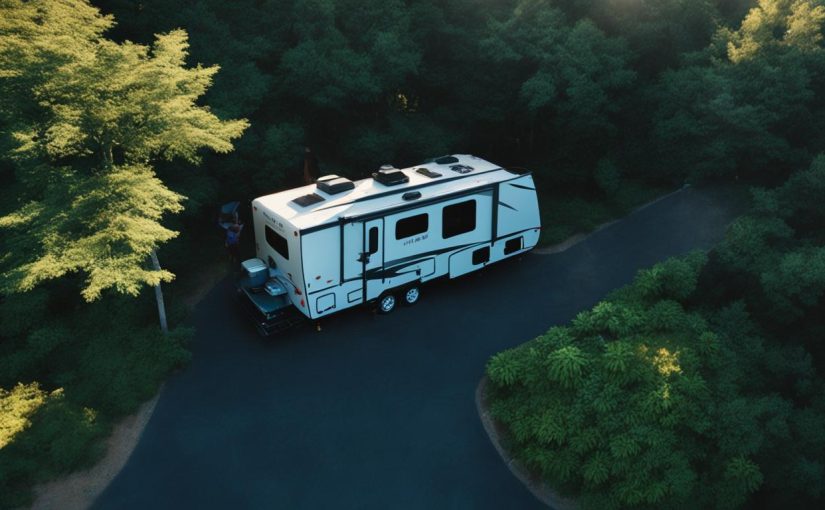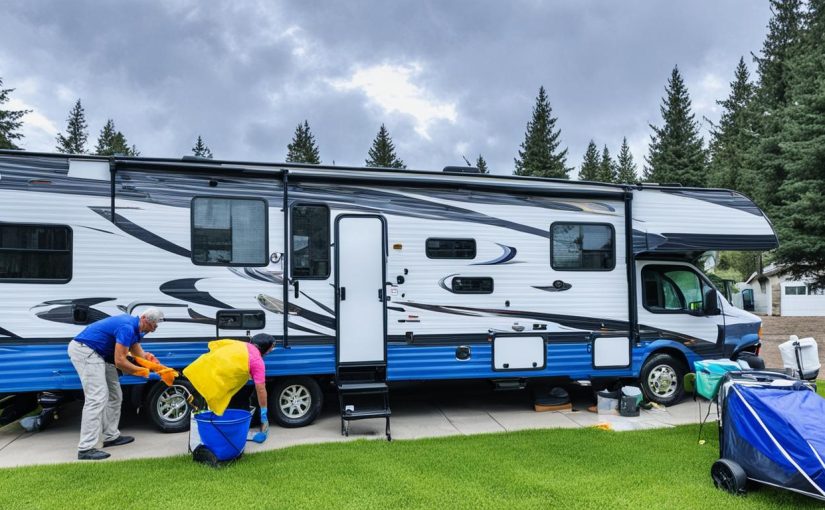Are you ready to hit the open road and embark on unforgettable adventures? Buying an RV can be a game-changer for travel enthusiasts, offering the freedom to explore new destinations while enjoying the comforts of home. But before you make that big purchase, it’s crucial to be well-informed and prepared. So, what exactly do you need to know when buying an RV?
In this comprehensive guide, we’ll walk you through everything you need to consider when purchasing an RV. From understanding different types of RVs to assessing your budget and exploring the pros and cons of new vs. used models, we’ve got you covered. We’ll also highlight important features to look for in an RV and provide insights on where to buy, whether from dealerships or private sellers.
By the end of this article, you’ll have the knowledge and confidence to choose the perfect RV that suits your needs and sets you on a path to incredible adventures.
Key Takeaways:
- Understanding the different types of RVs and their features is crucial before making a purchase.
- Assessing your budget and exploring financing options is important for budgeting and affordability.
- Weighing the pros and cons of new vs. used RVs will help you make the best decision.
- Identifying the essential features that enhance comfort and convenience is essential.
- Considering where to buy, whether from dealerships or private sellers, can impact your overall buying experience.
Understanding Different Types of RVs
Before embarking on your RV adventure, it’s essential to familiarize yourself with the different types of RVs available. Understanding the various categories, features, and limitations will help you make an informed decision when choosing the perfect RV for your needs.
RVs can be classified into several types, including Class A, Class B, and Class C motorhomes, as well as fifth wheels, travel trailers, popup campers, and toy haulers.
Class A motorhomes are the largest and most luxurious RVs, offering spacious living areas and amenities comparable to a home. They are ideal for long trips and full-time living.
Class B motorhomes, also known as camper vans, are compact and easily maneuverable. They are suitable for couples or small families looking for a versatile and fuel-efficient option.
Class C motorhomes offer a blend of comfort and affordability. They are built on a truck chassis and feature a distinctive over-the-cab area that provides extra sleeping space.
Fifth wheels are towable RVs that connect to a pickup truck using a specialized hitch. They offer ample interior space, often including multiple bedrooms and bathrooms.
Travel trailers vary in size, ranging from small, lightweight models to large units with multiple slide-outs. They can be towed by a variety of vehicles.
Popup campers, also known as tent trailers, are lightweight and easy to tow. They fold down for transport and expand into a comfortable living space at the campsite.
Toy haulers are designed for outdoor enthusiasts who want to bring along recreational vehicles such as ATVs or motorcycles. They feature a garage area at the rear.
Each type of RV has its own unique benefits and considerations. By understanding the different options available, you can narrow down your choices and find an RV that perfectly suits your travel style and preferences.
Assessing Your RV Budget
When it comes to purchasing an RV, it’s important to consider your budget beyond just the initial cost. Assessing your RV budget involves taking into account not only the purchase price of the RV itself but also the ongoing expenses that come with owning one. These expenses can include maintenance, insurance, campground fees, and more.
By thoroughly analyzing your budget, you can determine how much you can comfortably afford to spend on an RV and avoid any financial strain down the road. This will help you make a more informed decision and ensure that you choose an RV that aligns with your financial capabilities.
Financing options can also play a role in making RV ownership more affordable. Exploring different financing options available to you can provide you with greater flexibility in terms of your purchasing affordability. Whether you choose to finance through a bank, credit union, or RV dealership, understanding your financing options and terms can help you make a more informed decision.
To assess your RV budget effectively, consider all potential expenses and weigh them against your income and financial goals. By doing so, you can ensure that your RV purchase is not only a financial possibility but also a long-term investment that brings you joy and fulfillment on your future adventures.
New vs. Used RVs: Pros and Cons
When you’re in the market for an RV, one of the key decisions you’ll face is whether to buy a new model or a used one. Both options have their own advantages and disadvantages, and it’s important to consider them before making your decision.
Buying a new RV offers several benefits. Firstly, you’ll have access to the latest features and technologies. New RVs often come equipped with state-of-the-art amenities, modern design elements, and advanced safety features. Additionally, new RVs typically come with warranties that provide peace of mind. These warranties can cover various components of the RV, offering protection against unexpected issues that may arise.
On the other hand, buying a used RV can be a more affordable option. Used RVs are generally priced lower than their new counterparts, allowing you to get more value for your money. However, it’s important to thoroughly inspect a used RV and consider its maintenance history. Understanding the previous owner’s maintenance practices and any potential repairs or upgrades the vehicle may need is critical to ensure a smooth ownership experience.
When deciding between a new RV and a used RV, it’s essential to weigh the advantages and consider your specific needs and budget. If you prioritize having the latest features and warranties, a new RV may be the right choice for you. However, if budget is a primary consideration and you’re willing to put in the effort to assess a pre-owned RV’s condition, buying used can be a cost-effective solution.
No matter which option you choose, it’s crucial to do your research, take the time to inspect the RV thoroughly, and consider any maintenance or repair costs that may be involved. By carefully weighing the pros and cons and considering your individual circumstances, you’ll be able to make an informed decision that best matches your preferences and needs.
Important Features to Look for in an RV
When buying an RV, it’s crucial to identify the essential features that will enhance your comfort and convenience on the road. Whether you’re a full-time RVer or enjoy occasional getaways, having the right amenities and equipment can make a significant difference in your overall experience.
One of the first things to consider is the sleeping arrangements. Look for an RV that offers comfortable beds or sofas that can be easily converted into sleeping spaces. Having a good night’s sleep is essential for a rejuvenating travel experience.
The kitchen amenities are also important. Look for RVs with fully equipped kitchens, including a stove, oven, refrigerator, and microwave. These features allow you to prepare your favorite meals and enjoy home-cooked food even while you’re on the go.
Next, consider the bathroom facilities. Look for RVs with a functional bathroom that includes a toilet, shower, and sink. Having these amenities onboard ensures convenience and privacy during your travels.
Storage space is another vital feature to prioritize. Look for RVs with ample storage compartments, both inside and outside. This allows you to bring along all the necessary items without feeling cramped or cluttered.
Entertainment options are also worth considering. Look for RVs with built-in TVs, DVD players, or even outdoor entertainment systems. These features can provide entertainment during downtime or create a festive atmosphere for outdoor gatherings.
Remember, the right combination of features can make your RV feel like a home away from home. By prioritizing the must-have RV amenities that matter most to you, you’ll be able to narrow down your choices and find the RV that meets your needs and preferences perfectly.
Where to Buy: Dealerships vs. Private Sellers
When it comes to purchasing an RV, you have two main options: buying from a dealership or buying from a private seller. Both choices offer unique advantages, and it’s essential to understand the differences to make an informed decision.
If you decide to buy from a dealership, you’ll have access to a wide selection of RVs. Dealerships often have various models, sizes, and features to choose from, making it easier to find the perfect RV for your needs. Additionally, dealerships offer financing options, allowing you to spread out the cost of your purchase over time. This can be especially beneficial if you prefer to pay in installments rather than upfront.
Dealerships also provide warranties for their RVs, giving you added peace of mind regarding potential repairs and maintenance. With a warranty, you can enjoy the RV lifestyle without worrying too much about unexpected expenses.
On the other hand, purchasing from a private seller can offer some unique advantages as well. Private sellers often have more competitive prices compared to dealerships since they don’t have the same overhead costs. This can be particularly beneficial if you’re working with a tight budget and looking for a good deal.
Moreover, buying from a private seller can provide a more personalized experience. You can directly communicate with the owner, ask questions about the RV’s history and maintenance, and potentially negotiate the price. This level of interaction can give you a better sense of the RV’s condition and whether it meets your expectations.
When deciding where to buy, take into account your budget, desired level of support, and the condition of the RV itself. Assess your financial situation and determine if financing options are necessary. Consider the importance of warranties and the peace of mind they provide. Evaluate the overall condition of the RV and ensure it aligns with your expectations.
Remember that there are also online RV marketplaces that offer a range of purchasing options. These platforms connect buyers and sellers, providing a comprehensive inventory of RVs available for sale. This can be an excellent alternative if you want to explore a wide selection of RVs without the limitations of a physical dealership or private seller.
Whether you choose to buy from a dealership, a private seller, or an online RV marketplace, the key is to carefully weigh the benefits and consider your specific needs. By doing so, you’ll be able to make an educated decision and find the perfect RV for your adventures.
Pitfalls to Avoid When Purchasing an RV
Despite careful consideration, there are potential pitfalls to be aware of when purchasing an RV. To ensure a smooth and successful RV buying experience, it is important to be knowledgeable and vigilant, avoiding common mistakes and pitfalls. Here are some common RV buying mistakes to avoid:
- Relying on faulty inspections: When inspecting an RV, it is crucial to thoroughly examine the vehicle and hire professionals if needed. Common RV buying mistakes include overlooking hidden damages that can lead to unexpected repairs and expenses.
- Unknowingly purchasing an RV with undisclosed damages: Avoid pitfalls by requesting a comprehensive vehicle history report and thoroughly inspecting the RV before making a purchase. This will help you avoid surprises and ensure you are aware of any existing damages or issues.
- Unexpected hidden costs: Buyer beware of additional expenses that may arise beyond the initial purchase price of the RV. These can include maintenance and repairs, insurance, campground fees, and storage costs. It is important to factor in these expenses when assessing your budget.
- Overestimating your needs: Consider your lifestyle, travel plans, and the number of people who will be using the RV before making a purchase. Avoid the mistake of overestimating your needs and investing in a larger or more expensive RV that may not be necessary or practical for your specific circumstances.
By being mindful of these common RV buying mistakes and pitfalls, you can make an informed decision and ensure a smooth and enjoyable RV ownership experience.
Conclusion
To successfully finalize your RV purchase, it is crucial to conduct thorough research and make well-informed decisions. By utilizing this comprehensive RV buying guide, you have gained valuable insights into the different types of RVs, assessed your budgetary considerations, evaluated the pros and cons of new versus used RVs, and considered the important features that align with your preferences. Moreover, understanding where to buy and being aware of potential pitfalls empowers you to navigate the purchasing process confidently. Armed with this knowledge, you are now ready to embark on your RV buying journey and find the perfect RV for your adventures.
Remember, an RV is not just a vehicle; it is your home away from home on the road. By carefully considering your needs, preferences, and budget, you can make a well-informed decision that will enhance your future travel experiences. Whether you plan to explore the scenic national parks, embark on cross-country road trips with your family, or simply enjoy the freedom of the open road, your RV will be your trusted companion.
So, take the time to conduct thorough research, visit reputable dealerships or explore private seller options, and ask questions to gain clarity on any concerns you may have. With a clear understanding of what you are looking for, you can confidently negotiate the best deal and finalize your RV purchase. Get ready to make unforgettable memories and embark on countless adventures as you hit the road in your very own RV!
